-
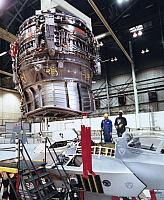
Here the X-35A is being converted to the X-35B. The X-35B features a unique shaft-driven lift fan that amplifies engine thrust and reduces temperature and velocity during STOVL operations. The JSF team successfully installed the shaft-driven lift fan in the JSF X-35B in less than three hours. [LMTAS photo]
-
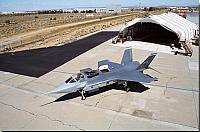
The X-35B, with more than 27 hours of flying time on its airframe, completed all of its conventional-flight requirements by May 2001. [LMTAS photo]
-
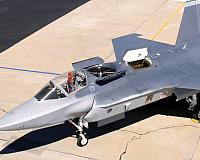
In May 2001 installation of the flight-ready shaft-driven lift fan began in the Lockheed Martin Joint Strike Fighter X-35B at the company's Palmdale, Calif., plant. [LMTAS photo]
-
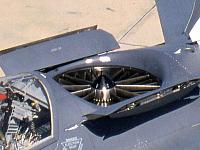
The shaft-driven lift fan propulsion system includes a thrust-vectoring rear nozzle, wing-mounted "roll post" ducts that provide lateral control and additional thrust, and a Rolls-Royce counterrotating fan - mounted immediately aft of the cockpit - driven by a Pratt & Whitney F119-611 engine via a drive shaft. The fan's cool thrust multiplies the engine's lifting force and contributes to a more benign ground environment. [LMTAS photo]
-
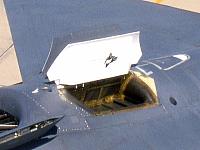
Another close-up of the X-35B. [LMTAS photo]
-
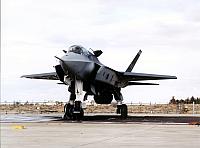
During early hover-pit tests, the X-35B's landing gear was replaced with a fixed "dummy" gear, essentially bolting the aircraft to the ground. The fixed gear contained strain gauges that measured forces in all dimensions. [LMTAS photo]
-
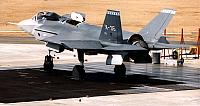
Most of the initial STOVL tests occured over a ten feet deep conrete pit covered with a thick metal grate. The pit reduced the ground effects produced from the engine and lift fan, and it allowed engineers to study vertical flight modes while the aircraft was on the ground. [LMTAS photo]
-
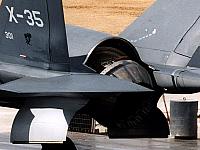
The X-35B runs its short to vertical landing propulsion system on a hover pit in Palmsdale, California. With the rear nozzle deflected downward and lift-fan doors it open position, as shown, the plane produces about 40,000 pounds of trust. [LMTAS photo]
-
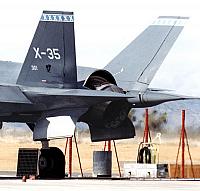
The 3 Bearing Swivel Nozzle [LMTAS photo]
-
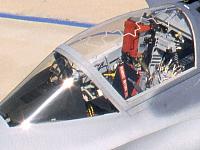
Cockpit of the X-35B [LMTAS photo]
-
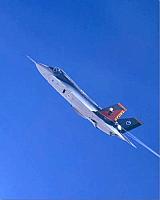
The X-35B's STOVL capability allows the aircraft to take-off and land with minimal or no runway space. [unknown photographer]
-

The Lockheed Martin Joint Strike Fighter X-35B opens the doors to its short-take off vertical landing [LMTAS photo]
-
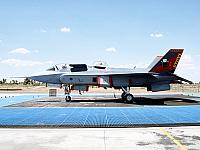
Ready to Jump The X-35B, shown at the LMTAS' facility in Palmdale, Calif., is undergoing final systems checks prior to a series of vertical takeoffs set for late June early July 2001. [LMTAS photo]
-
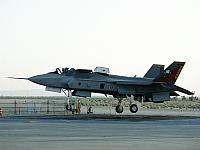
The X-35B floats above a hover pit at the company's Palmdale, Calif., plant on June 23th 2001, following its first vertical takeoff. The airplane landed vertically shortly afterward. [LMTAS photo]
-
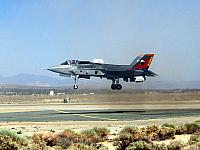
The supersonic Lockheed Martin Joint Strike Fighter X-35B descends vertically to a soft landing at Edwards Air Force Base , Calif., in July 2001. [LMTAS photo]
 Here the X-35A is being converted to the X-35B. The X-35B features a unique shaft-driven lift fan that amplifies engine thrust and reduces temperature and velocity during STOVL operations. The JSF team successfully installed the shaft-driven lift fan in the JSF X-35B in less than three hours. [LMTAS photo]
Here the X-35A is being converted to the X-35B. The X-35B features a unique shaft-driven lift fan that amplifies engine thrust and reduces temperature and velocity during STOVL operations. The JSF team successfully installed the shaft-driven lift fan in the JSF X-35B in less than three hours. [LMTAS photo] The X-35B, with more than 27 hours of flying time on its airframe, completed all of its conventional-flight requirements by May 2001. [LMTAS photo]
The X-35B, with more than 27 hours of flying time on its airframe, completed all of its conventional-flight requirements by May 2001. [LMTAS photo] In May 2001 installation of the flight-ready shaft-driven lift fan began in the Lockheed Martin Joint Strike Fighter X-35B at the company's Palmdale, Calif., plant. [LMTAS photo]
In May 2001 installation of the flight-ready shaft-driven lift fan began in the Lockheed Martin Joint Strike Fighter X-35B at the company's Palmdale, Calif., plant. [LMTAS photo] The shaft-driven lift fan propulsion system includes a thrust-vectoring rear nozzle, wing-mounted "roll post" ducts that provide lateral control and additional thrust, and a Rolls-Royce counterrotating fan - mounted immediately aft of the cockpit - driven by a Pratt & Whitney F119-611 engine via a drive shaft. The fan's cool thrust multiplies the engine's lifting force and contributes to a more benign ground environment. [LMTAS photo]
The shaft-driven lift fan propulsion system includes a thrust-vectoring rear nozzle, wing-mounted "roll post" ducts that provide lateral control and additional thrust, and a Rolls-Royce counterrotating fan - mounted immediately aft of the cockpit - driven by a Pratt & Whitney F119-611 engine via a drive shaft. The fan's cool thrust multiplies the engine's lifting force and contributes to a more benign ground environment. [LMTAS photo] Another close-up of the X-35B. [LMTAS photo]
Another close-up of the X-35B. [LMTAS photo] During early hover-pit tests, the X-35B's landing gear was replaced with a fixed "dummy" gear, essentially bolting the aircraft to the ground. The fixed gear contained strain gauges that measured forces in all dimensions. [LMTAS photo]
During early hover-pit tests, the X-35B's landing gear was replaced with a fixed "dummy" gear, essentially bolting the aircraft to the ground. The fixed gear contained strain gauges that measured forces in all dimensions. [LMTAS photo] Most of the initial STOVL tests occured over a ten feet deep conrete pit covered with a thick metal grate. The pit reduced the ground effects produced from the engine and lift fan, and it allowed engineers to study vertical flight modes while the aircraft was on the ground. [LMTAS photo]
Most of the initial STOVL tests occured over a ten feet deep conrete pit covered with a thick metal grate. The pit reduced the ground effects produced from the engine and lift fan, and it allowed engineers to study vertical flight modes while the aircraft was on the ground. [LMTAS photo] The X-35B runs its short to vertical landing propulsion system on a hover pit in Palmsdale, California. With the rear nozzle deflected downward and lift-fan doors it open position, as shown, the plane produces about 40,000 pounds of trust. [LMTAS photo]
The X-35B runs its short to vertical landing propulsion system on a hover pit in Palmsdale, California. With the rear nozzle deflected downward and lift-fan doors it open position, as shown, the plane produces about 40,000 pounds of trust. [LMTAS photo] The 3 Bearing Swivel Nozzle [LMTAS photo]
The 3 Bearing Swivel Nozzle [LMTAS photo] Cockpit of the X-35B [LMTAS photo]
Cockpit of the X-35B [LMTAS photo] The X-35B's STOVL capability allows the aircraft to take-off and land with minimal or no runway space. [unknown photographer]
The X-35B's STOVL capability allows the aircraft to take-off and land with minimal or no runway space. [unknown photographer] The Lockheed Martin Joint Strike Fighter X-35B opens the doors to its short-take off vertical landing [LMTAS photo]
The Lockheed Martin Joint Strike Fighter X-35B opens the doors to its short-take off vertical landing [LMTAS photo] Ready to Jump The X-35B, shown at the LMTAS' facility in Palmdale, Calif., is undergoing final systems checks prior to a series of vertical takeoffs set for late June early July 2001. [LMTAS photo]
Ready to Jump The X-35B, shown at the LMTAS' facility in Palmdale, Calif., is undergoing final systems checks prior to a series of vertical takeoffs set for late June early July 2001. [LMTAS photo] The X-35B floats above a hover pit at the company's Palmdale, Calif., plant on June 23th 2001, following its first vertical takeoff. The airplane landed vertically shortly afterward. [LMTAS photo]
The X-35B floats above a hover pit at the company's Palmdale, Calif., plant on June 23th 2001, following its first vertical takeoff. The airplane landed vertically shortly afterward. [LMTAS photo] The supersonic Lockheed Martin Joint Strike Fighter X-35B descends vertically to a soft landing at Edwards Air Force Base , Calif., in July 2001. [LMTAS photo]
The supersonic Lockheed Martin Joint Strike Fighter X-35B descends vertically to a soft landing at Edwards Air Force Base , Calif., in July 2001. [LMTAS photo]